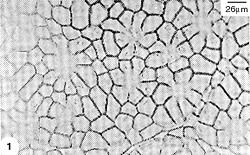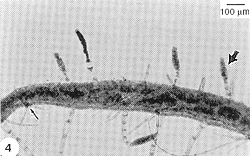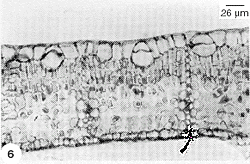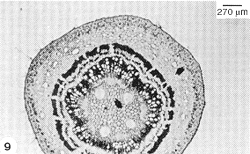The anatomy of the mature leaf and stem of the cacao tree is described in this study emphasizing the characterization of trichomes and secretory structures. Stem and leave ( limb and petiole) samples from the 3rd node and 5cm long young leaves were analysed. Leaf lamina is hypostomatic with anomocytic stomata. Four types of trichomes, two tectorial and two glandular occur in both limb surfaces. In the adaxial epidermis there are mucilage secretory glands. The mesophyll is dorsiventral; the palisade parenchyma is formed by two or three layers. The lacunary parenchyma has collecting cells. Along the mesophyll collateral bundles predominate involved by sclerenchymatic sheath extending up to the epidermis. Standard venation is of Camptodrome type with mixed Brochidrodomous and Eucamptodromous ramification. Petiole and stem show the epidermis with the same type of trichomes described to the limb. In their cortical and medullary parenchyma there are cells containing starch grains, idioblasts containing druses and mucilage canals. The vascular system along the petiole differentiates regarding the organization. The stem shows chlorenchyma and collenchyma layers. Sclerification of collenchyma occurs during the plant development. Discontinuous fiber ring of the primary phloem follows. Medulla is abundant and its sclerification occurs during the development.
cacao; Theobroma cacao L; anatomy; leaf; stem; secretory structures










